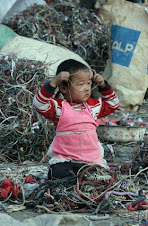June 15, 2009
Some See E-Waste Crisis Trailing Switch to Digital TV
By NATHANIAL GRONEWOLD and GREENWIRE
NEW YORK -- There's growing concern that the United States' conversion last weekend from analog to digital television broadcasting will exacerbate a national e-waste problem and fuel the smuggling of cathode ray tubes to the developing world.
The digital transition, coupled with the popularity of newer flat-screen TVs, could see millions of sets heading to landfills or loosely regulated recycling facilities over the next few years, experts say. The reason, they say, is the growth of high-definition channels that will remain off-limits to old TVs, even those with digital converter boxes.
E-waste watchdogs say electronics recyclers are already reporting a big influx of older televisions, especially in states where governments have instituted comprehensive recycling rules. Old TV sets hold large quantities of cadmium, lead and chemicals used to make plastics and other materials flame resistant.
"Both Washington and Oregon implemented their statewide e-waste programs in January, and they are both seeing more than half their volume in TVs," said Barbara Kyle, national coordinator at the Electronics TakeBack Coalition. Washington state is reportedly collecting more than 3 million pounds of old televisions a month, she said.
U.S. EPA estimates that there were almost 100 million old televisions in storage across the United States at the end of 2007. Though the nation is not likely to see a massive rush of old TVs inundating landfills or recyclers immediately, the volume of waste is expected to increase substantially over the next few years as consumers turn to newer, HD-ready sets and demand for older models declines.
"It's people's nature to hang onto working electronics, thinking they can find someone to give them to," said Kyle. "Some of those TVs in storage may have been donated by now, but the millions that are still there will become trash soon as people realize that no one is going to want their old analog TV, even if it's working."
Though electronics recyclers are noticing a jump in TVs landing in their yards, officials at Goodwill Industries say they have so far seen no similar boost in donations of old televisions, a sign that consumers may increasingly be seeing their old boxy sets as trash. Lauren Lawson, a media relations manager at Goodwill, said its stores have not been reporting larger numbers of television donations.
"We were actually one of the nonprofit partners for the DTV coalition," playing a role instead in helping get the message of the coming of digital TV to poorer households, Lawson said.
Seattle-based Basel Action Network (BAN), an organization pushing for the United States to ratify the Basel Convention on international hazardous waste shipment, estimates that at least one in four households will get rid of an old TV this year following the digital transition. That could come out to some 28 million cathode ray tubes -- each containing roughly 5 pounds of lead on average, depending on the screen size -- ending up in the waste stream.
Much of this waste will be recycled domestically. But Sarah Westervelt, a BAN official, said some 80 percent will actually be shipped abroad for processing in China and Africa, in violation of provisions of the Basel treaty that ban the shipment of toxic waste from the rich countries to poor ones.
"Exports are not quantified because the U.S. has not ratified the Basel Convention, and therefore we are not controlling or monitoring our exports," Westervelt said.
BAN has traced a lot of the electronic waste from the United States -- including old desktop computers, laptops, printers, televisions and more -- to a rough processing facility in Guiyu, China, and has produced documentaries on the unfortunate community there. Activists say residents there suffer some of the highest dioxin and lead poisoning in the world as they work through the e-waste in an uncontrolled and highly unsafe manner.
City-organized recycling events provide some of the greatest volumes of e-waste exports, BAN says, as municipal governments facing budget constraints cannot pay for processing and seek out vendors willing to collect the material for free.
"The only folks who are able to do this for free, from everything that we have learned over eight years of doing this work, are people who are exporting it," said Westervelt. "Otherwise, you end up with mercury and leaded glass and materials that you have to pay downstream vendors to manage responsibly."
Complacent EPA?
Kyle and others complain that EPA has so far remained complacent about the possibility that the digital transition will see a flood of toxic televisions to landfills or unsafe processing zones in the Third World.
Last week, EPA issued a statement urging consumers who toss out their sets in favor of newer models to "recycle their unwanted TVs, which recovers valuable materials from the circuit boards, metal wiring, leaded glass and plastics." The agency encouraged people to contact local hazardous waste authorities to find out how best to dispose of the old sets. But public information released by EPA ahead of the digital transition makes no mention of concerns over e-waste exports to the developing world.
EPA has stepped up controls on illegal e-waste exports after a 2008 report by the Government Accountability Office chided the agency for lax enforcement. Earlier this month, EPA filed a complaint against EarthEcycle for its alleged unauthorized export of hazardous cathode ray tubes.
EarthEcycle had collected the materials from recycling events held in the Pittsburgh area for the Humane Society and Make-a-Wish Foundation and exported the e-waste to Vietnam. The nonprofits apparently knew that much of the waste would be shipped abroad. EarthEcycle President Jeff Nixon recently told a local television station that his company had done nothing wrong, insisting that all the exported waste was headed for proper recycling facilities and should not end up in dumps
Tuesday, June 16, 2009
Thursday, June 4, 2009
Subscribe to:
Comments (Atom)













